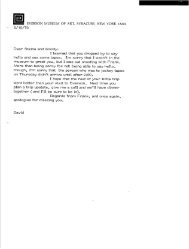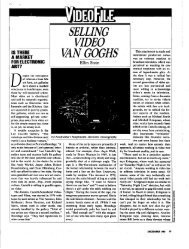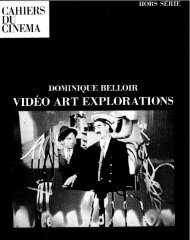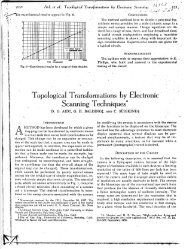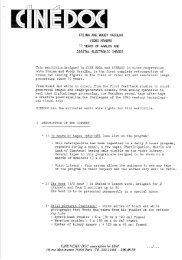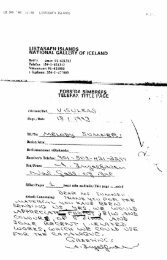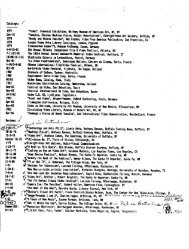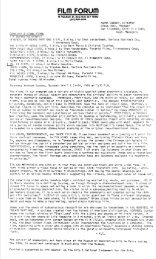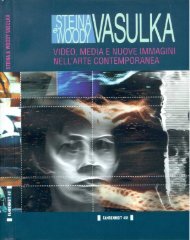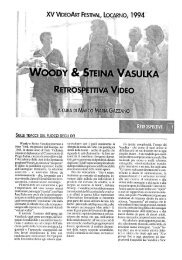MEDIA STUDY/BUFFALO - the Vasulkas
MEDIA STUDY/BUFFALO - the Vasulkas
MEDIA STUDY/BUFFALO - the Vasulkas
You also want an ePaper? Increase the reach of your titles
YUMPU automatically turns print PDFs into web optimized ePapers that Google loves.
Robert Ashley is known as a pioneer<br />
in <strong>the</strong> development of large-scale, collaborative<br />
performance works and new<br />
forms of opera such as That Morning<br />
Thing and In Memoriam. . .Kit Carson .<br />
Landmark recordings, such as She<br />
Was A Visitor and In Sara, Mencken,<br />
Christ and Beethoven There Were Men<br />
and Women, have pointed <strong>the</strong> way to<br />
new uses of language in a musical setting<br />
. His current works, operas for television<br />
entitled Perfect Lives and<br />
Atalanta, are continuations of his longtime<br />
interest in and use of visual media<br />
to express musical ideas . Ashley<br />
was born in Ann Arbor, Michigan and<br />
educated at <strong>the</strong> University of Michigan<br />
and <strong>the</strong> Manhattan School of Music.<br />
During <strong>the</strong> 1960's, he was a coorganizer<br />
of <strong>the</strong> ONCE Group, a music<strong>the</strong>ater<br />
collaborative that toured <strong>the</strong><br />
United States from 1965 to 1969 . From<br />
1966 to 1976, he toured internationally<br />
with <strong>the</strong> Sonic Arts Union, a composers'<br />
collective that include David<br />
Behrman, Alvin Lucier and Gordon<br />
Mumma . Ashley was Director of <strong>the</strong><br />
Center for Contemporary Music at Mills<br />
College, Oakland, from 1969 to 1981 .<br />
During 1975 and 1976, he produced<br />
and directed Music With Roots in <strong>the</strong><br />
Ae<strong>the</strong>r, video documents of <strong>the</strong> work<br />
and ideas of seven major contemporary<br />
American composers . In 1978,<br />
<strong>the</strong> Kitchen commissioned Perfect<br />
Lives, an opera for television in seven<br />
half-hour episodes. The series has<br />
been purchased by The Fourth Channel<br />
(Great Britain) and is scheduled for<br />
broadcast in Britain in <strong>the</strong> spring of<br />
1984.<br />
Steina<br />
Paul Sharits<br />
Robert Ashley<br />
Tony Conrad<br />
Brian Henderson<br />
Hollis Frampton, Associate Professor<br />
at <strong>the</strong> Center for Media Study,<br />
SUN .Y/Buffalo, has completed over<br />
forty films. He also designed <strong>the</strong><br />
Center's Digital Arts Laboratory in 1977<br />
in response to a need for a reintegration<br />
at both <strong>the</strong>oretical and practical<br />
levels of <strong>the</strong> several disciplines of film<br />
and video. making, photography and<br />
sound syn<strong>the</strong>sis and processing, as<br />
<strong>the</strong>se all relate to <strong>the</strong> interfacial modes<br />
of computing . Frampton's work is<br />
represented in <strong>the</strong> collections of <strong>the</strong><br />
Museum of Modern Art, Anthology<br />
Film Archives, <strong>the</strong> Carnegie Institute<br />
and elsewhere, and <strong>the</strong> Royal Film Archive<br />
in Brussels, Belgium, preserves<br />
<strong>the</strong> entire body of his work . Since 1972,<br />
Frampton has been at work on Magellan,<br />
a film cycle of epic proportions, and<br />
has had major retrospectives at <strong>the</strong><br />
Walker Art Center, <strong>the</strong> Museum of<br />
Modern Art, and <strong>the</strong> Fifth International<br />
Festival of Experimental Film in Belgium<br />
. A major exhibition of his filmic<br />
and photographic work is planned at<br />
<strong>the</strong> Ablright-Knox Art Gallery in <strong>the</strong> fall<br />
of 1984 . Recently, a collection of,<br />
Frampton's <strong>the</strong>oretical texts on film, still<br />
photography and video, 1968-80, entitled<br />
Circles of Confusion, was published<br />
by <strong>the</strong> Visual Studies Workshop,<br />
and he was <strong>the</strong> recipient of a coproduction<br />
award, through Media<br />
Study/Buffalo, for a new film, R .<br />
Filmmaker and visual artist Paul<br />
Sharits is currently an Associate<br />
Professor at <strong>the</strong> Center for Media<br />
Study at SONY/Buffalo . Major exhibitions<br />
of his work include Dream Displacement<br />
and O<strong>the</strong>r Projects at <strong>the</strong><br />
Albright-Knox Art Gallery in 1976, and<br />
a retrospective at Anthology Film Archives<br />
in New York in 1980, in conjunction<br />
with <strong>the</strong> publication of a special<br />
double-issue of Film Culture dedicated<br />
to Sharits' collected writings on film .<br />
He has received grants from <strong>the</strong> American<br />
Film Institute for <strong>the</strong> production of<br />
Razor Blades in 1968, grants from <strong>the</strong><br />
National Endowment for <strong>the</strong> Arts to<br />
produce multi-screen installations in<br />
1974 and 1979, and a Bicentennial<br />
Grant from <strong>the</strong> New York State Council<br />
on <strong>the</strong> Arts to produce Declarative<br />
Mode in 1976 . Sharits recently received<br />
an Individual Artist Grant from <strong>the</strong> Media<br />
Arts Program of <strong>the</strong> NEA to complete<br />
several new works which will<br />
explore <strong>the</strong> potentials of a<br />
microprocessor-governed electronic<br />
color-generator system which was developed<br />
in collaboration with Woody<br />
Vasuika and Tony Conrad, and which<br />
was programmed by David Held .<br />
r



